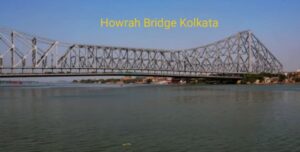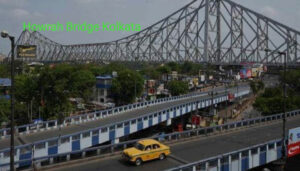Howrah Bridge Kolkata, a city steeped in history and culture, is home to many landmarks, but none as iconic as the Howrah Bridge. Spanning the Hooghly River, this engineering marvel connects the bustling city of Kolkata with its twin city, Howrah. Known for its impressive architectural design and cultural significance, Howrah Bridge stands as a testament to human ingenuity and resilience. This blog delves into the rich history, architectural feats, and cultural importance of Howrah Bridge, making it a must-read for anyone interested in Kolkata’s heritage.

1. Howrah Bridge Kolkata: History and Background
The story of Howrah Bridge dates back to the early 20th century. The bridge was conceptualized to replace an older pontoon bridge that was becoming inadequate due to increasing traffic. The construction of Howrah Bridge, also known as Rabindra Setu, began in 1936 and was completed in 1942. It was officially opened to the public in February 1943.
The bridge was designed by the renowned engineering firm, Rendel, Palmer and Tritton, and constructed by the Braithwaite, Burn & Jessop Construction Company. The project was a significant milestone during British colonial rule in India and marked a major advancement in engineering and design
2.Howrah Bridge Kolkata:Architectural and Engineering Feats
Howrah Bridge is a cantilever bridge, a design that was revolutionary at the time of its construction. It spans 705 meters (2,313 feet) and is 30 meters (98 feet) wide, making it one of the longest cantilever bridges in the world. The bridge was built without using any nuts and bolts; instead, it was riveted, which was a major engineering achievement.
One of the most impressive aspects of Howrah Bridge is its ability to withstand heavy loads. Designed to carry a mix of vehicular and pedestrian traffic, it supports over 100,000 vehicles and countless pedestrians daily. The main towers of the bridge, rising to 90 meters (295 feet), are made of high-tensile alloy steel, which was sourced from Tata Steel in Jamshedpur.

3. Howrah Bridge Kolkata: Howrah Bridge Today
Today, Howrah Bridge remains an essential artery for Kolkata’s transportation network. It connects the city with Howrah Railway Station, one of India’s busiest railway hubs. The bridge sees a daily traffic of around 150,000 pedestrians and 100,000 vehicles, making it one of the busiest cantilever bridges globally.
The maintenance of Howrah Bridge is a continuous effort. Regular inspections and repairs ensure that the bridge remains safe and functional despite the heavy traffic and environmental factors. The Kolkata Port Trust, responsible for the bridge’s upkeep, employs modern technologies and methods to preserve this historical structure.
4. Howrah Bridge Kolkata: Cultural Significance
Howrah Bridge is more than just a means of transportation; it is a cultural icon. It has been featured in numerous films, both Bollywood and international, such as “Howrah Bridge” (1958) and “The Namesake” (2006). Its majestic presence has inspired poets, writers, and artists, becoming a symbol of Kolkata itself.
For the residents of Kolkata, Howrah Bridge is a part of their daily lives. It serves as a backdrop for countless stories, from romantic encounters to poignant farewells. Festivals and events, like Durga Puja, see the bridge adorned with lights and decorations, enhancing its splendor and importance in the city’s cultural tapestry.
5.Howrah Bridge Kolkata: Tourism and Photography
Howrah Bridge is a top attraction for tourists visiting Kolkata. Its grandeur and historical significance make it a must-visit landmark. The best viewpoints for photography include the nearby Mallick Ghat Flower Market and the Hooghly River banks. Early morning and late evening provide the perfect lighting conditions to capture stunning images of the bridge.
For photography enthusiasts, tips include using wide-angle lenses to capture the entire span of the bridge and experimenting with different perspectives, such as shooting from boats on the Hooghly River. The interplay of light and shadow, especially during sunrise and sunset, can result in breathtaking shots.
6. Environmental Impact
The construction and operation of Howrah Bridge have significantly impacted the surrounding environment. Efforts have been made to minimize its ecological footprint, including pollution control measures and maintenance practices that reduce harmful emissions. The bridge also plays a crucial role in the river ecosystem by facilitating the movement of goods and people, contributing to the local economy.
7.Fun Facts and Trivia
– Howrah Bridge was initially named the New Howrah Bridge to distinguish it from the older pontoon bridge.
– The bridge’s steel structure weighs approximately 26,500 tons.
– It was painted with a special aluminum paint to protect it from corrosion.
– Howrah Bridge holds the Guinness World Record for being the busiest cantilever bridge.
– The bridge’s design was influenced by the conditions of the Hooghly River, which experiences heavy tides and currents.
Conclusion:
Howrah Bridge is not just an architectural wonder but a living, breathing part of Kolkata’s identity. Its historical significance, cultural impact, and engineering brilliance make it a landmark worth celebrating. As we look at this iconic structure, we are reminded of the ingenuity and resilience that went into its creation. Whether you are a resident or a visitor, Howrah Bridge is a symbol of connection, endurance, and the rich heritage of Kolkata.
FAQ:
1.Why is Howrah Bridge famous in Kolkata
2.What is the new name of Howrah Bridge?
3.Which bridge links Howrah to Kolkata?
4.How many Howrah bridges are there?
5.10 Lines on Howrah Bridge
6.Howrah Bridge – wikipedia
7.Howrah Bridge photos
8.Why Howrah Bridge is famous
9.Who built Howrah Bridge
10.Does Howrah Bridge open from middle


Pingback: Gol Gumbaz: The Architectural Marvel of Bijapur - solotraveler